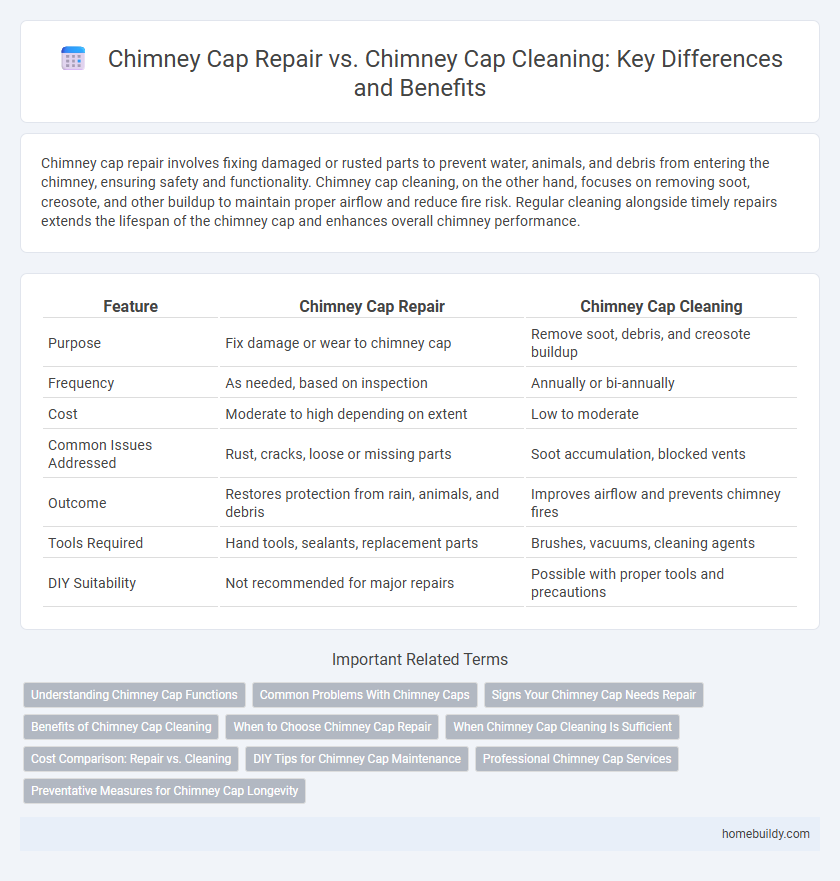Chimney cap repair involves fixing damaged or rusted parts to prevent water, animals, and debris from entering the chimney, ensuring safety and functionality. Chimney cap cleaning, on the other hand, focuses on removing soot, creosote, and other buildup to maintain proper airflow and reduce fire risk. Regular cleaning alongside timely repairs extends the lifespan of the chimney cap and enhances overall chimney performance.
Table of Comparison
| Feature | Chimney Cap Repair | Chimney Cap Cleaning |
|---|---|---|
| Purpose | Fix damage or wear to chimney cap | Remove soot, debris, and creosote buildup |
| Frequency | As needed, based on inspection | Annually or bi-annually |
| Cost | Moderate to high depending on extent | Low to moderate |
| Common Issues Addressed | Rust, cracks, loose or missing parts | Soot accumulation, blocked vents |
| Outcome | Restores protection from rain, animals, and debris | Improves airflow and prevents chimney fires |
| Tools Required | Hand tools, sealants, replacement parts | Brushes, vacuums, cleaning agents |
| DIY Suitability | Not recommended for major repairs | Possible with proper tools and precautions |
Understanding Chimney Cap Functions
Chimney cap repair addresses structural damage that prevents proper venting and protects against rain, debris, and animal intrusion, ensuring the chimney's safety and efficiency. Chimney cap cleaning removes soot, creosote, and buildup that can obstruct airflow and increase the risk of chimney fires, maintaining optimal draft performance. Understanding these functions highlights that repair restores the cap's protective integrity while cleaning preserves its operational efficiency.
Common Problems With Chimney Caps
Chimney caps often face common problems such as rust, corrosion, and damage from weather exposure, which necessitate timely repairs to maintain their protective function. Cleaning chimney caps removes soot, creosote buildup, and debris that can block ventilation and increase fire risk but does not address structural damage or rust. Regular inspection distinguishes between when cleaning is sufficient and when repair or replacement is required to prevent issues like water leaks or animal intrusion.
Signs Your Chimney Cap Needs Repair
Signs your chimney cap needs repair include visible rust, cracked or missing components, and excessive debris buildup that cannot be removed through cleaning. Unlike routine chimney cap cleaning, which focuses on removing soot and nesting materials, repair addresses structural damage that can lead to water infiltration or animal entry. Ignoring repair signs can result in costly damage to the chimney's integrity and increased fire hazards.
Benefits of Chimney Cap Cleaning
Chimney cap cleaning enhances ventilation efficiency and prevents soot buildup, reducing fire hazards and improving indoor air quality. Regular cleaning extends the lifespan of the chimney cap by protecting it from corrosion caused by creosote and debris accumulation. Unlike repair, cleaning is a cost-effective maintenance step that preserves the chimney's structural integrity and ensures optimal performance.
When to Choose Chimney Cap Repair
Choose chimney cap repair when visible damage such as cracks, rust, or missing parts compromises the cap's integrity and allows debris, animals, or water to enter the chimney. Unlike routine chimney cap cleaning, which prevents soot buildup and maintains airflow, repair is essential if the cap no longer fits securely or shows signs of corrosion affecting its performance. Timely chimney cap repair protects the chimney structure and enhances safety by preventing blockages and moisture damage.
When Chimney Cap Cleaning Is Sufficient
Chimney cap cleaning is sufficient when there is only minor debris buildup, such as leaves or soot, that obstructs airflow and can be easily removed without damaging the cap. Signs indicating cleaning suffices include minimal rusting, intact mesh screens, and no visible cracks or structural wear. Chimney cap repair becomes necessary when corrosion, holes, or loose fittings compromise the cap's ability to protect the chimney from rain, animals, and sparks.
Cost Comparison: Repair vs. Cleaning
Chimney cap repair typically costs between $150 and $500, depending on the extent of damage and materials needed, while cleaning ranges from $100 to $300, primarily covering labor and debris removal. Repair expenses increase with issues like rust, cracks, or missing components, whereas cleaning focuses on maintaining airflow and preventing blockages at a lower cost. Prioritizing regular cleaning can reduce the frequency of costly repairs by preventing deterioration of the chimney cap over time.
DIY Tips for Chimney Cap Maintenance
Chimney cap repair involves fixing damaged or rusted components to prevent water, debris, and animals from entering the chimney, while chimney cap cleaning focuses on removing soot, creosote, and bird nests to maintain proper airflow and reduce fire hazards. DIY chimney cap maintenance tips include regularly inspecting the cap for rust or cracks, using a wire brush to clean debris, and applying a rust-resistant paint to prolong its lifespan. Ensuring the chimney cap is securely fastened and free of blockages enhances chimney safety and efficiency.
Professional Chimney Cap Services
Professional chimney cap services specialize in both chimney cap repair and cleaning, ensuring optimal protection against weather damage and debris buildup. Repair services address issues such as rust, cracks, and loose fittings that compromise the chimney's integrity, while thorough cleaning removes soot, creosote, and nests to maintain proper ventilation and safety. Choosing expert chimney cap technicians guarantees precise diagnostics, high-quality materials, and prolonged chimney cap lifespan, enhancing overall fireplace efficiency and home safety.
Preventative Measures for Chimney Cap Longevity
Chimney cap repair addresses physical damage like cracks or rust to prevent water infiltration and animal entry, while chimney cap cleaning removes soot and debris that can cause corrosion or blockage. Regular cleaning ensures proper ventilation and reduces fire hazards, whereas timely repairs maintain structural integrity and prevent costly damage. Both preventative measures significantly extend chimney cap longevity by preserving its functionality and durability.
Chimney cap repair vs Chimney cap cleaning Infographic

 homebuildy.com
homebuildy.com